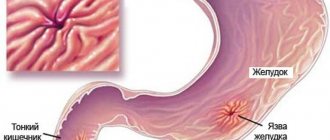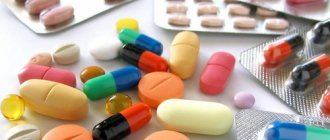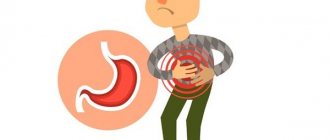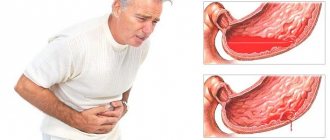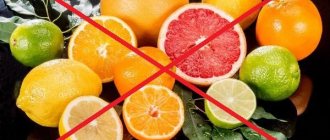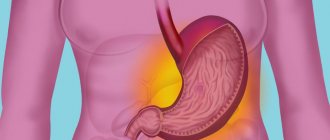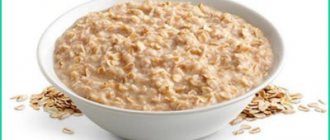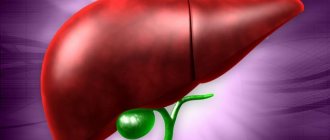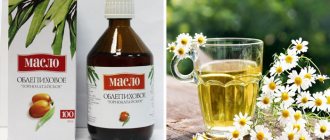Solcoseryl in injections is prescribed to improve the process of cellular nutrition, to stimulate regeneration and enhance metabolism. The medication is able to activate the regenerative and reparative effect in cells, stimulates the production of collagen in the walls of blood vessels, increases glycolysis, increases ATP synthesis, improves access of glucose and oxygen to cells that are in the stage of hypoxia.
What injections are given for stomach ulcers?
For open gastric and duodenal ulcers, more than 1-2 groups of drugs are used simultaneously. Thanks to this, greater effectiveness of treatment is achieved due to the combined action of medications. In addition, their combinations are selected in such a way that they enhance each other’s effects.
The list of medications depends on the severity of the disease and accompanying symptoms. It may include:
- painkillers - Analgin;
- antispasmodics - No-shpa;
- histamine receptor blockers - Ranitidine, Kvamatel;
- proton pump inhibitors - Omeprazole, Lansoprazole;
- antiemetics - Cerucal, Metoclopramide;
- antibiotics - Clarithromycin, Amoxicillin;
- agents that stimulate mucosal healing - Solcoseryl, Actovegin.
Let us consider in detail the most popular medications prescribed to almost all patients during the acute period of the disease.
Solcoseryl
The drug belongs to the biogenic stimulants. Its action is aimed at improving metabolic processes and increasing oxygen saturation of tissues. As a result, activation of regeneration of damaged areas is observed.
Solcoseryl for stomach ulcers is prescribed for the purpose of scarring the ulcerative surface.
Injections of the drug are well tolerated, only in rare cases allergic reactions are observed. The reason for this is the composition of Solcoseryl. It contains dialysate from the blood of dairy calves, which has a biogenic effect.
The solution can be administered intravenously and intramuscularly. The choice of method of administration is made by the doctor after assessing:
- depth of ulcerative processes;
- frequency of disease relapses;
- the general condition of the patient, including age and the presence of concomitant chronic diseases.
The advantage of the drug is its ability to be used with other antiulcer drugs.
Also, treatment with Solcoseryl can continue during the recovery period after the acute condition has resolved.
Kvamatel
The drug contains as an active substance a blocker of H2-histamine receptors - famotidine. It reduces the basal production of hydrochloric acid, and also inactivates its secretion mediated by external stimuli. As a result, the environment becomes less acidic, which reduces the effect of pepsin. This leads to the cessation of the corrosive effect of gastric juice on the gastric mucosa.
Kvamatel is often prescribed in complex treatment. It helps to enhance the antibacterial effect of drugs used to eliminate Helicobacter pylori infection. The regenerative ability of the mucous membrane also increases, especially when using regenerants and reparants.
A feature of famotidine is the lack of influence:
- for bowel movements;
- enzymatic function of the pancreas;
- blood circulation in the portal system and in the vessels of the liver.
The standard dose is 20 mg every 12 hours.
The drug is administered only intravenously at a slow speed:
- intravenous injection - about 2 minutes;
- infusion - 15-20 minutes.
Since Kvamatel is produced in the form of a lyophilisate, it requires preliminary dissolution. The solvent used is saline solution (0.9%) sodium chloride, ampoules of which are included with the active substance (in one package). But other colorless transparent solutions of substances that do not interact with famotidine can also be used.
Ranitidine
Actovegin
Based on the type of action it produces, it is classified as a tissue regeneration stimulator.
The drug consists entirely of physiological compounds isolated from the blood of calves (hemoderivative obtained by dialysis and ultrafiltration).
Actovegin increases tissue repair:
- due to the positive effect on the transport and utilization of glucose;
- increasing oxygen consumption by cells;
- increasing the concentration of amino acids, ATP and ADP (substances necessary for tissue regeneration).
Due to their similar effects on the body, Actovegin and Solcoseryl can be used interchangeably.
The drug solution can be administered:
- intravenously;
- infusion;
- intra-arterial;
- intramuscularly.
It is recommended to start therapy with 5-10 ml, as there is a risk of anaphylactic reaction. Further dosage depends on the response to treatment and is determined by the doctor.
Attention! All manipulations related to the dissolution and administration of injectable forms of drugs can only be carried out by medical personnel.
These drugs are most often used for stomach and duodenal ulcers. They help faster healing of ulcerative surfaces. Medicines also have other forms of release intended for oral or local (Solcoseryl) use. But administration in the form of injections significantly increases their effectiveness and speed of action. If necessary, treatment can be continued after the acute period, but the decision on this is made by the doctor.
Description and features of the medicine
The action of the drug "Solcoseryl" is aimed at improving metabolic processes, accelerating the transfer of oxygen and glucose in the blood to damaged tissues, which stimulates their regenerative function. This biogenic medicine is obtained from the blood of newborn calves, which is previously purified in a special way from the protein mass. This release of the extract from the reactive protein makes it possible to reduce the antigenic effect of the drug.
The drug saturates tissues with purine and amino acids.
Medicine is prescribed in the form of gels, jellies, creams, pastes for external, that is, local use. Injection options are administered intramuscularly or intravenously. For open gastric ulcers, only Solcoseryl injections are used. You can take pills. The injection solution is offered for sale in ampoules of 2 ml, of which there are 10 units in one box.
The main advantage of Solcoseryl is its ability to saturate damaged tissues with the help of the active ingredient with substances such as purine and amino acids. These components are needed to ensure proper metabolism. The presence of polypeptides allows you to maintain the normal functioning of tissues in the body.
A combination of biogenic injections and antibiotics is acceptable.
Atrophic gastritis: how to properly treat a disease with high acidity
The crazy pace of life of residents of megacities has a negative impact on their health. The reason for this is not only environmental factors and stressful conditions, but also basic rules regarding healthy eating. Violation of the regime, preference for fast food (fast food) lead to the appearance of atrophic gastritis. Its insidiousness lies in the fact that at an early stage there are no symptoms of the disease, and the patient is diagnosed only with serious disorders of the gastrointestinal tract.
Painkillers
How to treat gastritis accompanied by severe pain? They appear as a result of irritation of its inflamed mucous membrane with hydrochloric acid, the appearance of spasms of muscle tissue. To reduce discomfort, both antacids and antispasmodics are needed. It is recommended to take painkillers for gastritis as prescribed by a gastroenterologist, since some drugs can only worsen the condition.
What can you drink for gastritis from painkillers? No-shpa and Papaverine are most often used to relieve spasms. These medications are good at relaxing smooth muscles. When using them, caution should be exercised, since an overdose can lead to neurological disorders manifested by seizures and hallucinations.
To relieve a painful attack, you need to take No-shpa
For severe pain, it is recommended to use anticholinergics that act on stomach receptors. The drugs Atropine and Difacil have a pronounced effect.
Painkillers are contraindicated in Crohn's disease, tuberculosis, and also if a gastrointestinal infection is present. It should be remembered that severe pain can develop with acute appendicitis, peritonitis, or perforation of a stomach ulcer. In such situations, a painkiller pill can only worsen the condition.
Also, for aggravated gastritis, sedatives (Novopassit, Neozepam) are indicated. Herbal complexes based on motherwort and valerian have a good sedative effect. A sedative drug should be chosen only on the recommendation of a specialist, since not all medications are indicated for inflammation of the stomach.
It all starts small
Peptic ulcer disease is a chronic disease with a polycyclic course, characterized by the occurrence of an ulcerative defect in the mucous membrane of the stomach and duodenum.
An ulcer of the digestive organ, as a rule, is a consequence of severe inflammation of the walls of the stomach. May be the result of untreated Helicobacter gastritis. There is an ulcer as an independent disease, and there are secondary symptomatic and gastroduodenal ulcers, provoked by stress, circulatory disorders, taking certain anti-inflammatory drugs, etc.
Gastritis is an inflammation of the stomach lining. Due to a pathological process in the digestive organ:
nutrients that come with food are less easily absorbed;
the activity of all systems is disrupted, metabolism suffers;
sometimes this leads to increased acidity, which destroys the walls of the stomach;
- sometimes leads to a lack of acid, as a result of which food is poorly digested, stagnates in the stomach, and enters the intestines with a delay.
The result of advanced gastritis, as a rule, is a stomach and duodenal ulcer or atrophy of the gastric mucosa, or cancer.
What is the secret of this unique product?
Solcoseryl for gastritis is an instant lifesaver that quickly and effectively eliminates the symptoms of the disease and reduces the inflammatory process. This is a biogenic stimulant. It activates the processes of regeneration and metabolism in the body, eliminates inflammation, and how this happens is still not completely clear to science.
In general, biogenic stimulants are formed in the tissues of animals and plants in stressful situations under the influence of unfavorable conditions (cooling, being in the dark, etc.). This is how nature made sure that living organisms had a chance to survive, despite everything. The nature of biological stimulants still remains a mystery to science. As a rule, biological stimulants are a complex complex of substances.
With stomach and duodenal ulcers, ulcers threaten to perforate the walls of the stomach, causing a severe inflammatory process of the entire peritoneum and gastrointestinal tract. This usually leads to death.
Several injections of Solcoseryl allow you to saturate the tissues with oxygen, which contributes to the rapid healing of all ulcers. Moreover, this remedy also leads to the regeneration of epithelial tissue, that is, it restores the mucous membrane of the digestive organ.
What is the composition of Solcoseryl and what does it contain?
The drug was made from the blood of a newborn calf, but at the same time, it was completely purified from protein and other unwanted substances.
This medication contains:
- Blood of newborn calves.
- Propyl and methyl acid.
- Para-hydroxybenzoic acid.
Thanks to these elements, ulcerative wounds and inflammatory processes go away, and the functioning of the stomach and digestive system as a whole is also restored, and this is of great importance. But there may be allergic reactions to the components of the drug themselves, so it is recommended to immediately visit a gastroenterologist and allergist to make sure that this drug is not harmful and contraindicated.
The product in action
Treatment of such a dangerous pathological condition as a stomach or duodenal ulcer should always be carried out under the supervision of a doctor. Self-medication for ulcers is life-threatening!
If the doctor prescribes and recommends for use the Swiss drug Solcoseryl, the instructions for use, injections for stomach ulcers (as Solcoseryl is sometimes called) should be studied in more detail.
It has been proven by practice that in most cases, injections for stomach ulcers (Solcoseryl) in the general treatment regimen significantly improve the effectiveness of therapy. Unpleasant sensations such as nausea and heartburn noticeably decrease within a week. The pain that occurs (a characteristic sign of a peptic ulcer) subsides and disappears after 1-2 weeks.
And in general, the general well-being of patients improves greatly: appetite appears, good mood appears, irritability and nervousness disappear.
Solcoseryl - Reviews
Description and instructions of Solcoseryl
Solcoseryl is an effective biogenic drug produced in Switzerland based on a protein-free extract of the blood of dairy calves. This drug improves metabolism and metabolism in tissues, as a result of its action tissues regenerate faster. First of all, Solcoseryl is prescribed for vascular diseases: obstruction, venous insufficiency. The drug is prescribed intravenously and intramuscularly. After epithelialization of wounds, Solcoseryl is used only externally.
Solcoseryl is produced in the form of an injection solution, ointment, and eye gel. Active treatment is carried out for 4-8 weeks, the maintenance course lasts another 2-3 weeks. Solcoseryl is prescribed in combination with antibiotics and other drugs. It significantly improves tissue trophism and stimulates regeneration. Solcoseryl improves the transport of glucose and oxygen in cells, promotes ATP synthesis, improves aerobic glycolysis, stimulates the formation of fibroblasts and collagen synthesis, especially in the walls of blood vessels. It is often used as part of complex therapy for the treatment of arthrosis.
Indications for use
- venous insufficiency, vascular obstruction, decreased vascular tone in diabetes;
- for trophic ulcers, skin defects, plastic surgeries;
- 2-3 degree burns, bedsores;
- when tissue is destroyed due to prolonged exposure to liquid;
- for corneal lesions: keratitis, erosion, ulcers, chemical burns, keratoplasty, infectious dystrophy, etc.;
- for radiation, radiation and chemical skin lesions;
- for trophic skin lesions - ulcers and gangrene;
- for duodenal and gastric ulcers;
- for pneumonia, chronic colitis;
- for traumatic brain injuries;
- with ischemic and hemorrhagic stroke.
Contraindications
To date, no contraindications have been identified. Driving is not recommended when using the eye gel.
However, Solcoseryl is not recommended:
- children under 18 years of age;
- patients with sensitivity to E216, E218 and E210;
Side effects
There are no side effects; when using external preparations, there may be a slight burning sensation at the site of application. No negative effects were observed during pregnancy, however, it is recommended to use only as prescribed by a doctor and under close supervision. Data on the effect during lactation are unknown, but treatment with Solcoseryl is discontinued during breastfeeding. There are no data on use in children.
There may be hyperemia and slight swelling at the injection site. When using Solcoseryl systemically, it is necessary to monitor blood serum levels.
Solcoseryl is not compatible with ginkgo biloba extract, naftidrofuryl, bencyclane fumarate.
Reviews of Solcoseryl
Reviews of Solcoseryl indicate that the drug is especially effective for stomach ulcers, as it significantly reduces pain and improves epithelization of the ulcer.
During lactation, Solcoseryl helps with cracked nipples, as well as any non-healing wounds. At the same time, the healing process proceeds differently for different women. At the same time, the drug perfectly helps with household burns, calluses, and scratches. When treating, the ointment should not be applied to purulent wounds.
This drug is very helpful in treating venous insufficiency.
Solcoseryl is used in cosmetology to activate the synthesis of fibroplasts, with some specific data regarding cosmetic use.
Pros:
Solcoseryl is a biogenic drug that promotes tissue regeneration. This drug is very effective in the treatment of complex lesions of blood vessels and skin, to improve tissue trophism.
Minuses:
At the same time, drugs based on blood extract, despite all their effectiveness, have not been sufficiently studied, therefore, in the absence of actual contraindications, this drug is not used for the treatment of children and pregnant women.
You should know it
The instructions for use of the drug from the Swiss company describe in detail what effect it has on the body. Solcoseryl has another unique property - it triggers a self-healing mechanism, that is, self-regulation of disorders of the mucous membrane of the digestive organ occurs. And not only does the stomach feel better, but also the liver. The drug removes toxic substances accumulated due to the disease from the body.
The duration of therapy using Solcoseryl depends on the degree of inflammatory processes. As a rule, 1-2 months are enough for the ulcers to heal completely.
Important! The simultaneous use of antibiotics and the use of Solcoseryl injections has no contraindications. The medicine is not addictive.
Instructions for use of the injection solution
When conducting a course of Solcoseryl injections, a positive effect on the chemical and physical properties of the stomach itself is recorded. At the same time, internal processes are activated, which inhibit the processes of tissue destruction; gastric juice does not “corrode” existing ulcerations
. Noticeable improvements are also observed in the condition of the liver tissue. In addition, the process of gradual removal of toxins from the body takes place.
Typically, treatment with Solcoseryl for gastritis and ulcers follows an individually selected regimen, taking into account the nature of the disease and the presence of complications. The standard treatment regimen involves administering injections for 30-60 days; during this period, scarring of existing epithelial defects is observed.
If the patient has a tendency to seasonal exacerbation of the disease, it is recommended to extend the treatment course for 2 weeks, the frequency of injections is 1-2 times. during the week.
Detailed instructions for using Solcoseryl are here.
How to enter
Solcoseryl injections for ulcerative process can be administered either intramuscularly or intravenously. The first option is the most common. For the intramuscular option, the following scheme is used:
on the first day, one 2 ml ampoule of the product is enough;
on the second day this dose is twice as large;
on the third day and in the next 18 days, 6 ml injections are administered.
If you administer the drug intravenously, you must do it very slowly, without mixing the medicine with any other drugs.
Contraindications
Despite its safe composition, the drug Solcoseryl is prescribed by a doctor based on diagnostic test data. The main restrictions on the use of the product are:
- renal failure, replacement therapy for chronic renal failure;
- children under 18 years of age;
- pregnancy and breastfeeding;
- pathologies of the heart and blood vessels;
- diseases of the hematopoietic organs;
- history of pulmonary edema.
Breastfeeding is a contraindication to the use of solcoseryl for ulcers.
Contraindications are relative, since data on the study of the effect of the drug Solcoseryl on various groups of patients is scarce and practically absent. A direct limitation to use is intolerance to animal dialysis, the individual sensitivity of the body to the component of the drug.
